Abstract
This paper investigated the process of code-switching in Urdu weblogs authored by Pakistani bloggers as code-switching has always been an intriguing phenomenon to sociolinguists. The research objectives of this study are to investigate the data of Urdu weblogs to identify and describe the patterns of code-switching in the blog entries authored by Pakistani bloggers. This study utilized the quantitative and qualitative approaches. In the present study, 20 Urdu blog entries authored by 10 Pakistani bloggers are analyzed to examine the occurrence of English code-switches. Lexical switches are the most frequently occurring type of code-switching found in the data. The results of this study indicate that the code-switched language in Urdu weblogs is primarily an extension of the written or spoken form of language. However, it also has certain distinctive features that set it apart from code-switched language in other genres. The findings showed that Pakistani bloggers, who are multilingual internet users, usually use this mode of communication to fully express themselves because they live between two worlds-virtual and real, two cultures, and two languages.
Key Words
Computer-mediated Communication, Code-switching, Urdu Weblogs, Pakistani Bloggers, Bilinguals
Introduction
The invention of language(s) predates the invention of the wheel in the history of humanity. The history of language is as old as the entity of language itself. The advancement of communicative ways that have coincided with the development of human intellect has laid the groundwork for language evolution. The current status of languages has made the use of numerous languages imperative, particularly in casual settings. Code-mixing and code-switching are global linguistic phenomena that have grown in popularity as a result of this tendency. This phenomenon is mostly observed in face-to-face interactions, conversations in chat rooms, blogging websites, social media, etc. Code-switching is a generic term that covers a linguistic phenomenon emerging from the contact of languages in bilingual situations. This phenomenon appears in various syntactic levels and a variety of modes of communication such as Computer-Mediated Communication i.e. by using two distinct languages in a discourse.
Technology is advancing so quickly, and people are using the Internet so frequently that every facet of modern life is quickly moving to digital form. A dynamic and expansive environment for linguistic and sociolinguistics research is provided by Computer-Mediated Communication (CMC), a communicative setting in which the language is extensively explored. Higgins (1991) provided the broad definition of Computer-Mediated Communication as ‘human communication by the use of computer’. Technology-based tools like computers are employed in this kind of communication. Numerous modern technologies and services enable the presence of Computer-Mediated Communication. Interpersonal communication is made possible through the use of computers and other networks. It includes electronic mail (Email), online chat rooms, video conferencing, bulletin boards, weblogs, channels of instant messaging, and other social media networks.
Despite the end of colonialism, the English language is still a vital component of post-colonial history, literature, and culture as stated by Talaat & Anwar (2010). Pakistan does not appear to be an exception in this context. The educated multilingual Pakistanis make regular and efficient use of both Urdu and English language in their daily lives to coordinate with people and organize a variety of activities. The main objective of this study is to investigate the practice of code-switching in Pakistani Urdu weblogs. This research looks at instances of code-switching in the English language found in Urdu weblogs.
Research Objective
1. To investigate the linguistic data of Urdu weblogs authored by Pakistani bloggers in order to identify and examine the patterns of code-switching found in Urdu weblogs.
Research Questions
In this research paper, the following research questions are addressed:
1. Do Pakistani bloggers freely switch languages in Urdu weblogs?
2. What are the patterns of code-switching found in Urdu weblogs authored by Pakistani bloggers?
Literature Review
Bilingual speakers practice more than one code at the same time as proposed by Cakrawarti (2011). Code-switching is examined as a skill of bilingual speakers. Bilingual moderators can speak two or more languages in a single discussion. They utilize multiple languages (code) in their conversation. In doing so, they alter their code according to the situation. This alternation in code is called code-switching. Most people use two or more languages and require a selected language whenever they want to speak with one another. Grosjean (1989) proposes that the one way to study language is to look at the language from its point of view. This approach also involves the investigation of language choice. The choice of language demonstrates the fluency of bilinguals in spoken language. In fact, the listener's linguistic skill frequently determines this choice.
Code-switching: A Phenomenon Involving Bilingualism and Multilingualism
According to McArthur (1998), most language researchers designate the speakers of two or more languages as "multilingual" or "bilingual". According to Fabbro (1999), a person is considered "bilingual” if they can speak two languages fluently or if they frequently use two languages in daily conversation. Multilingual people are sometimes referred to as "polyglots". A multilingual individual can speak and understand three or more languages, either separately or in different combinations. Other scholars, like Wei (2013) have characterized bilingualism and multilingualism in very similar ways.
A well-known theory developed by Poplack in 1980 distinguishes the three types of code-switching: tag-switching, intra-sentential switching, and inter-sentential switching. According to Blom and Gumperz (1972), Gumperz (1956 & 1982), Myers-Scotton (1993a), and other scholars, code-switching is a social communicative strategy that serves specific socio-cultural purposes. The first school of thought views code-switching as a socially dynamic tool in bilingual or multilingual speech.
The Linguistic Heritage of Pakistan
Gordon (2005) stated that there are around 6,000 distinct languages spoken worldwide. In Pakistan, English has been declared as the official language and it is widely spoken and understood. The 1973 Constitution of Pakistan states in clause (I) that Urdu is the national language of Pakistan. Within fifteen years of its adoption, steps must be taken to use it for official and other purposes. Subject to clause (I) of the constitution, English may be utilized by speakers for official purposes till the plans are made for Urdu to take its place.
Figure 1
Figure 1

Since the 1947 partition, Pakistan has enjoyed the diversity of languages spoken in its four provinces. According to Haider & Fang (2019, p. 166), Pakistan is home to about sixty different languages. Every province has speakers speaking major and minor languages. Pakistan is a multilingual and culturally diverse nation, Mansoor (2004, p. 53) claims that the selection of a language for instruction is not a simple task.
Linguistic map of Pakistan
Pakistan recognizes English and Urdu as its two official languages. In addition to Urdu, there are over fifty regional languages and six major languages. The principal regional languages are Hindko, Balochi, Saraiki, Sindhi, Punjabi, and Pashto. Minor languages including Potohari, Wakhi, Shina and Broshishki are widely spoken in the northern areas of Pakistan. English is frequently used in the administrative and servicing departments of Pakistan. It is also used among the elite class of Pakistani society. Urdu is currently being used as the official language of Pakistan. It is utilized extensively in daily life. Merely, 8% of Pakistani citizens speak Urdu as their mother tongue as quoted by Faruqi (2003). Most Pakistanis are able to understand and speak Urdu language. On the other hand, more people speak Saraiki, Pashto, Sindhi, and Punjabi. For communication purposes, both Urdu and English are allowed for communication.
Anwar (2009) has analyzed Urdu-English code-switching in the Pakistani context. The main focus of his study was to find the instances of code-switching in the form of phrases and clauses in English newspapers and magazines and analyse code-switching as a grammatical phenomenon. Onysko (2006) argues that code-switching is a common phenomenon that is found all over the world. English is a worldwide language, and its influence can be seen in German magazines like Der Spiegel-2000, where the German language is often replaced by English code.
A research study conducted by Al Heeti and Al A (2016) in Iraq proposed that code-switching is seen as a widespread multipurpose conversational skill of multilingual communicators in both formal and casual settings. The method of questionnaires was used to conduct interviews with Iraqi doctors to collect the data by recording audio. Doctors employed English code during the meeting instead of the Arabic language. The main reason to use English code was that they used to study in the Faculty of Medicine and had been learning English for about eight years. They had articulated it in classes, clinics, and hospitals. They considered English as an impressive and informative language as compared to the Arabic language. The central aim of this study was to pick up instances of inter-tag code-switching, inter-sentential code-switching, and intra-sentential codeswitching from doctors' conversations. Talaat (2005) postulated that the change in the linguistic environment of Pakistan can be attributed to code-switching. Pakistani English undergoes linguistic innovation due to the Urdu-English code-switching.
Yousaf (2004) claims that the Pakistani language is ever-evolving. A Pakistani child grows up learning his mother tongue at home. Then, he becomes acquainted with the Urdu language by communicating outside the home. He will need to learn English as he gets older for both scholastic and professional reasons. The Pakistani speakers now mostly communicate in English. In both formal and casual contexts, English is utilized in addition to Urdu. When investigating the practice of code-switching, Niazi and Khan (2003) found that the fluency in English language was regarded as a mark of achievement and high status among the teenage bilingual students registered in private schools.
Weblogs: A Recent Communicative Space
In the last twenty years, a plethora of new digital communication spaces have emerged. A new tool for communication has been introduced recently, the weblog. Weblogs, often known as blogs, are a type of online communication that is gaining popularity nowadays. They are characterized as regularly updated web pages with dated content arranged in reverse chronological order. Blog posts often include articles, rants, photos, memories, jokes, and reflections on various topics. A blog might be solely focused on one subject, or it can showcase the writer's current interests. Blog writers are referred to as "bloggers". A blog can have one author or several authors. According to A. P. Cambell (2003), a weblog is a type of online journal that a person can quickly update with their own words, ideas, and thoughts using blog software.
Figure 2
Weblogs Retrieved from ‘Introduction to Blogging’ by Duke University

English Code-switching in Pakistani Urdu Weblogs
About 430 million people use English as their second language (L2 speakers) and 330 million people use English as their first language globally as stated by Crystal (2003, p. 65). English is used more often by non-native speakers than by native speakers. It may be studied as a second language by a billion people worldwide. The speakers of nearly every country in the world use English to communicate with each other. Since English is becoming more and more common, people have begun using it in non-native contexts. It is known as a transplanted language resultantly.
According to Kachru (1986, p.30), a language could be deemed transplanted if a sizable portion of speakers use it in socio-cultural or geographic situations that differ from those in which it was first employed. When a language is transplanted, it loses its connection to its native environment. It learns to function in new roles and situations.
Linguistics Face Web Technologies: Electronic Communication
The story of the explosive growth of the Internet in Pakistan as a medium for communication and information sharing is one of the amazing and contentious changes in a traditionally conservative nation. The advent of the Internet and the quick spread of electronic communication have sped up the creation of new language varieties. It led to considerable linguistic changes that were used on the Internet. Graddol (1997) provided support for the theory that cutting-edge technological communications promote the emergence of new linguistic variants.
One common type of Computer-Mediated Communication that enables user interaction is electronic discourse. It results in a discourse that lies halfway between written and spoken modes of communication as claimed by Lee (2009). As a result, the conversation is just as interactive as the one that takes place in person. Crystal (2003, p. 433) stated that an electronic discourse is employed as a means of information transmission known as Computer-Mediated Communication.
It is an unusual form of communication as compared to face-to-face interaction.
A collection of web-based applications known as Web 2.0 technologies expands on the theoretical and technological underpinnings of contemporary technology. According to Kaplan and Haenlein (2010, p. 61), it has made the creation and circulation of user-generated content (UGC) easier. Web 2.0 technologies encompass a broad spectrum of ideas; including increased user-generated data and content, content sharing, collaboration and creative ways to engage with web-based services. The phenomenon of code-switching in online environments has been the subject of numerous studies by linguists. For example, Goldberg (2009, p. 3) investigated the process of code-switching in emails of cyberspace users. According to the findings of this research, the speakers of the minority language employed their language outside of their professional life and activities related to their occupations in a range of circumstances.
Blogs are a very common and widespread type of social media that release content for a wider audience rather than for only personal connections as stated in the distribution model proposed by Landers & Goldberg (2014, p. 286). Thanks to online communication the speakers can now easily, swiftly, and cheaply connect with one another. New languages have subsequently surfaced on the face of the Internet. Crystal (1997) claimed that English is the de facto language of cyberspace. The novel contact scenarios have been created by the users' interactions on the internet.
Weblogs were selected for the current study primarily due to their "rich sample of the ways in which language is utilized in written form." Blogging offers a distinct perspective on language usage. One could think of this new type of computer-mediated communication as a cross between spoken and written language. Weblogs were selected for the current study primarily due to the accessibility of a rich sample of data and the ways in which the written form of language is being utilized in this medium. Blogging offers a distinct perspective on language usage. One could think of this new type of Computer-Mediated Communication as a cross between verbal and written language.
The results of this study provide insight into the trends of online textual communication related to code-switching. The results of this study help us understand the phenomenon of code-switching in the Pakistani blogosphere. Code-switching is a phenomenon that occurs when people communicate virtually on different social networking sites, including weblogs. Bilinguals and multilinguals frequently use the process of code-switching on social networking platforms and the findings will make them aware of the significance of this study. Language instructors and policymakers are driven and prepared to pursue language change through the utilization of data from online communication channels. Thus, the findings of this study are beneficial to them.
Theoretical Framework of the Study
Due to the existence of multilingual communities in Pakistan, code-switching takes place in Pakistani weblogs. This research study has utilized the theoretical framework for the classification of code-switching provided by Montes-Alcala (2007). It was also supplemented by the ideas of Muysken and Appel (2005). This research study employed the following categories of code-switching:
Table 1
|
S. No |
Code-Switching
Categories |
|
1 |
Lexical
Switches |
|
2 |
Switches
for Quotations |
|
3 |
Switches
for Emphasis |
|
4 |
Triggered
Switches |
|
5 |
Switches
for Elaboration |
|
6 |
Tag
Switches |
However, the conclusion of the current study showed that the occurrence of switches concurrently served several socio-pragmatic functions. On the other hand, there is an overlapping of the switches in different categories as well.
Research Methodology
Research Design
The nature of the current study is qualitative as well as quantitative. This research study gives a clear image of English code-switching in Urdu weblogs by creating a balance between qualitative and quantitative data. The best approach to qualitatively analyze the data of weblogs in the form of code-switching categories was to apply the descriptive content analysis research paradigm. It allows for adequate answers to the primary research questions and its subsidiary inquiries.
The code-switching categories utilized in
the Urdu blogs were found and described by using the content analysis method, taking into account their lexical, socio-pragmatic and semantic functions. The switched categories were manually coded during the course of the inquiry. This investigation computed the frequency count.
Sample of the Study
The sample used in the study was the community of Pakistani bloggers. Ten bloggers who identified as male and ten bloggers who identified as female made up the sample size for this investigation. Twenty (20) blog posts covering a period of two to five years were selected for the study. Each blogger had two posts selected for this analysis. Single-authored blogs were taken into consideration. Urdu blogs from online weblog directories were chosen to create the corpus of the study.
Table 2
|
S. No. |
Blogs in Urdu authored by
Pakistani Bloggers |
Nos. |
|
1. |
Urdu Weblogs |
10 |
|
2. |
Blogs in Urdu authored by
male bloggers from Pakistan |
05 |
|
3. |
Blogs in Urdu authored by
female bloggers from Pakistan |
05 |
Table 3
|
Pakistani Bloggers |
Gender |
Location |
Switch From |
|
Blogger 01 |
Male |
Pakistan |
Urdu to English |
|
Blogger 02 |
Male |
Pakistan |
Urdu to English |
|
Blogger 03 |
Male |
Pakistan |
Urdu to English |
|
Blogger 04 |
Male |
Pakistan |
Urdu to English |
|
Blogger 05 |
Male |
Pakistan |
Urdu to English |
|
Blogger 06 |
Female |
Pakistan |
Urdu to English |
|
Blogger 07 |
Female |
Pakistan |
Urdu to English |
|
Blogger 08 |
Female |
Pakistan |
Urdu to English |
|
Blogger 09 |
Female |
Pakistan |
Urdu to English |
|
Blogger 10 |
Female |
Pakistan |
Urdu to English |
Research Procedure
The data of this study was categorized and arranged chronologically. The blog entries written by Pakistani bloggers were manually read and reviewed. The words, phrases, clauses, and sentences of each randomly chosen blog post were underlined in order to identify the English switches. The quantification method, which included counting the frequency of code-switches, was used to evaluate and contextualize the transcripts of the data. The study demonstrated the quantity of English switches that appeared in the Urdu blog post using the frequency count or occurrence of code-switches. Tables, bar charts, and pie charts were used to display the data.
Ethical Consideration
According to Fowley & Thousny (2013), the use of content or data from the internet is considered public domain because user authorization is not required. Consequently, the Internet is a globally interconnected network system. It is thought to be a unique type of public space. The researcher eliminated the demographic information and websites in order to preserve the privacy of the personal information of Pakistani bloggers. The participants of this study were represented anonymously. All relevant information was kept confidential.
Data Analysis of the Study
In order to study the code-switching process in bilingual journals, Montes-Alcalá (2007) observed this process in bilingual articles. She found out that most of the features common to oral forms of code-switching are also present in private diaries, such as weblogs. Consequently, the results of her research show that blogs and other public journals also demonstrate socio-pragmatic functions. The categories provided by Montes-Alcalá (2007) served as the basis for the classification utilized in this investigation. Table 4 shows the frequency and percentage of English switches for each category discovered in Pakistani Urdu weblogs.
Table 4

Table 5 presents the category-wise breakdown of the code-switching process used in the blog posts of Pakistani male bloggers in Urdu weblogs.
Table 5
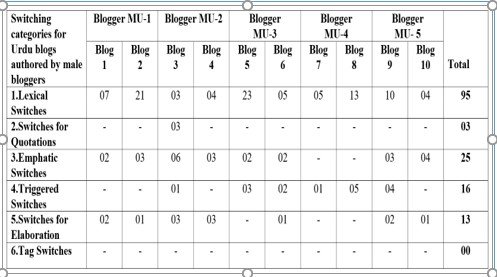
Table 6 presents the category-wise breakdown of the code-switching process used in the blog posts of Pakistani female bloggers in Urdu weblogs.
Table 6

It is clear that there are variations in the distribution of code-switches in Urdu weblogs. It is not uniform even within a single blog post. The overlapping of English switches in Urdu weblogs under various categories was also found. In this study, the bloggers switched at higher frequency for categories such as lexical items and triggered switches and no instance of tag switch was found in the data of Pakistani Urdu weblogs.
Findings and Discussion
Lexical Switches Found in Pakistani Urdu Weblogs
When there is a lack of precise or equivalent words in the other language, lexical switches are utilized. Montes-Alcala (2007) provided the definition of lexical switches as the words or noun phrases that are switched because of bilingualism or a lack of linguistic proficiency. The most prevalent kind of switch in the English language found in Urdu weblogs was a lexical switch with 3.7% of instances. The biculturalism of the user is more strongly linked to lexical switching (which involves single words or entire noun phrases) rather than the speaker's lack of proficiency in any of the languages used for communication. Accordingly, every word or phrase of Urdu blogs is rooted in the culture of the Urdu world. English is extensively utilized on the internet as being the dominant language of communication on the Internet. The users of the English language regularly utilize the term "Internet" as this study demonstrates the common usage of this term in Urdu blog posts. Throughout the current research investigation, even if the textual sequence of blog posts was available in Urdu, all Internet-related terminologies including blogs, entries, posts, websites, and social media, were available in English language.
Examples of contemporary technology jargon, such as "website" (??? ???? ), and "mobile" (??????) can be found in Pakistani Urdu blogs. It was discovered that the process of lexical borrowing was clearly present in the blog entries written by bilingual authors. Zentella (1997) described "crutching" as the process in which the speaker is unable to recall the term. For example, an Urdu-speaking interlocutor may use an English term like "okay", "bye", or "thanks" at the conclusion of an Urdu conversation. The examples of linguistic hybridization found in Pakistani Urdu weblogs are also found in the data such as; ?????/ ??????/ /????
The following are some instances of lexical switches employed by Pakistani bloggers in their Urdu blog posts:
Figure 3
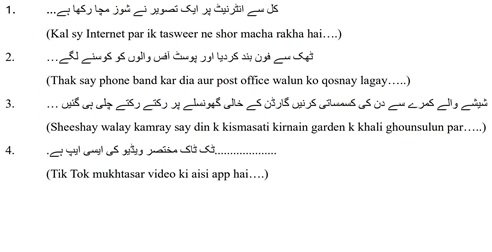
Figure 4
Lexical Switches Found in Urdu Weblogs
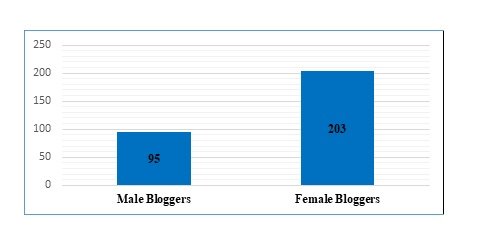
Switches for Quotations Found in Pakistani Urdu Weblogs
Tannen (2007, p.112) proposed that speech is fundamentally altered when it is repeated in a different context and language. It leads to the creation of fabricated conversations or reported speech. The speakers typically use quotations to reference other speakers' words in a different language. A bilingual speaker usually switches to the other language when they hear direct quotations. The only words that are switched in quoted form are those that the speaker asserts as the other speaker's statement. They can be quoted in their original language with a set of quotation marks. Brabanter (2004, p.1) suggested that the speakers of one language will occasionally interject quotations from another language into their writing or speaking. Such quotations provide yet
another example of language interaction.
Quotations are basically employed to portray and enact a more comprehensive viewpoint on the current situation. According to Finnegan (2011, p.74), quotation could function as a technique of succinct but pensive summarization, clarification, illustration, and justification. The quoted material may be employed for the endless variety of human activities and interactions. It can be used for fascination, analogies, deceit, ridiculing, sarcasm, adding colour and delight to discussion, expressing empathy and understanding, and much more. The findings of this study revealed that 0.06% of switches for quotations were used in the data of Urdu weblogs.
The following are some instances of switches for quotations employed by Pakistani bloggers in their Urdu blog posts:
Figure 5
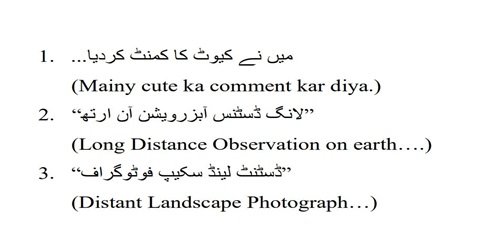
Figure 6
Switches for Quotations Found in Urdu Weblogs
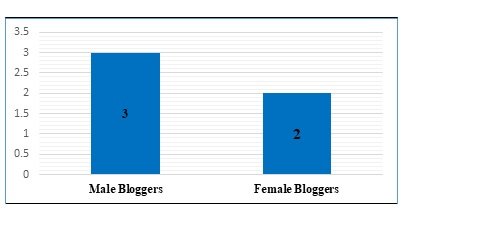
Emphatic Switches Found in Pakistani Urdu Weblogs
Myers-Scotton (2002, p.3) provided the definition of code-switching as the utilization of dual languages in the same section to put emphasis or to demonstrate stress. Montes-Alcala (2007) used the term foregrounding to emphasize a point. Gumperz (1977) stated that when words are repeated in a different language, it usually serves to highlight or even explain what is being said.
According to Mahootian (2006), the emphatic role of code-switching is linked to a meta-level action of communication in which the discourse form (mixed speech) focuses more on the speaker. To put it another way, the emphatic function is used to convey feelings and emotions. Hoffman (1991) asserts that when someone wants to be emphatic about something, they often translate from one language to another, whether on purpose or accidentally. In this study, the findings demonstrated the employment of 0.053% of emphatic switches by Pakistani bloggers in Urdu weblogs.
The following are some instances of emphatic switches employed by Pakistani bloggers in their Urdu blog posts:
Figure 7
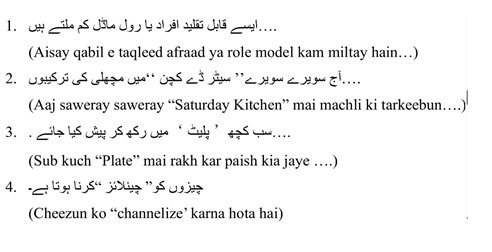
Figure 8
Emphatic Switches Found in Urdu Weblogs

Triggered Switches Found in Pakistani Urdu Weblogs
Montes-Alcala (2007, p.34) stated that the scholarly literature has noted that occasionally a word or statement that is switched can cause a switch in what comes before or after it. According to De Bot et al. (2009), code-switching is more likely to occur in situations where triggering is more likely to occur. Thus, the lexical co-activation caused by trigger words is negligible.
A triggered switch is defined by Valdés-Fallis (1976) as one that is set off by a single lexical transition, such as the ones covered in the preceding section. The data revealed that the frequency of triggered switches was 0.86%. This group contains instances such as Doctor (?????), Science (?????) etc.
The following are some instances of triggered switches utilized by Pakistani bloggers in their Urdu blog posts:
Figure 9
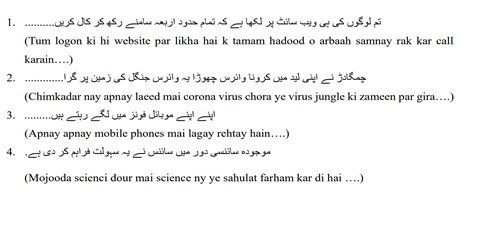
Figure 10
Triggered Switches Found in Urdu Weblogs

Switches for Elaboration Found in Pakistani Urdu Weblogs
According to Gumperz (1982) and Montes-Alcala (2007), these switches fall under the category of switches which are used for "message qualification". These switches are used to describe or offer further information. It is used to further elucidate the concept or to offer more details. This class of code-switching is known as "paraphrase" as stated by Valdés-Fallis (1976). The findings of this study revealed that there were around 0.20% of elaborative switches in the data from Urdu weblogs.
Dykes (2009) stated that multilingual-speaking communities use code-switching, a common yet complex linguistic approach, to create and communicate meaning beyond what is possible with a single language. Code-switching is typically sub-conscious and rule-governed behaviour.
According to Ajmal (2010, p.310), the speakers frequently change their code to clarify or convey a crucial point throughout the communication process. In this study, bloggers have changed their code during a communication process in order to clarify or translate a crucial message.
The following are some instances of this category employed by Pakistani bloggers in their Urdu blog posts:
Figure 11
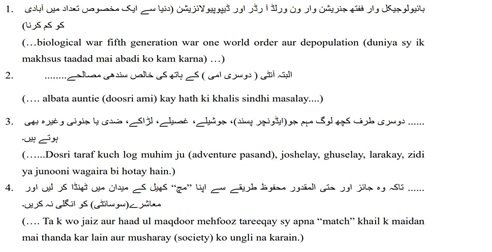
Figure 12
Elaborative Switches Found in Urdu Weblogs
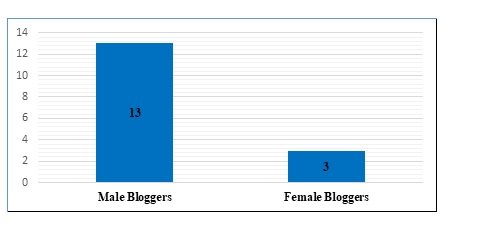
Tag Switches Found in Pakistani Urdu Weblogs
Tag Switching is the process of adding a tag or brief sentence from one language into an entirely non-English utterance. Tags usually have few syntactic constraints when they are added to a phrase that is written in L1. According to Hamers & Blanc (2000), tags do not break the syntactic norms. Interjections, colloquial terms, and fillers such as 'you know', 'okay' and 'right' are examples of tags.
This study demonstrated that there was no tag-switching used by Pakistani bloggers in their blog entries. The data of Urdu blogs written by male and female bloggers from Pakistan showed no instance of tag switch.
Figure 13
Tag Switches Found in Urdu Weblogs
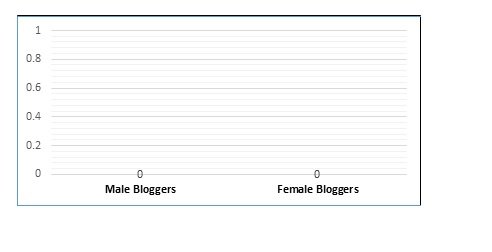
Conclusion
In Pakistan, code-switching is a common practice, especially among young and educated people who frequently use social media. Most of this practice stems from past interactions with former British colonies. The field of Computer-Mediated Communication is relatively new, with limited research conducted on investigating the code-switching process in languages other than English. As a result, linguistic researchers are now interested in the topic of language choice online. The code-switching process has been found in the Pakistani blogosphere, particularly in Urdu weblogs. Blogs are opinions and discussions posted for the public to see, not just the author to read. They are not a series of notes. Bloggers write with the intention of reaching a global readership, although they target no specific audience. Bloggers find it effortless to employ colloquial language due to their involvement in online communities. Blogs offer a wealth of information for linguistic research. While many linguistic academics have studied Pakistani multilingualism in spoken and written language, this study helps to illustrate the patterns of code-switching that Pakistani Internet users employ for blogging.
Given that the objectives of the current study were to identify and analyze the Urdu weblogs written by Pakistani bloggers, a few clear outcomes emerge from the findings. The findings showed that bloggers change codes or languages for posting in these kinds of public journals. The code-switching process has commonly been connected to the social stigma in spoken forms of communication. It has been noted that informal writing is not subject to this stigma, at least not in online democratic communication spaces. In this study, code-switching in Computer-Mediated Communication happened less frequently than in in-person interactions or written correspondence.
The blurring of the lines between spoken and written language is, therefore, one of the most noteworthy features of Computer-Mediated Communication as stated by Herring (2001). Textual communication within Computer-Mediated Communication contexts—particularly synchronous communication—shares most of the traits generated in face-to-face encounters. Pakistani bloggers were found to use all forms of code-switches except tag switching in this investigation.
The data from Pakistani Urdu weblogs showed that the lexical switches were the most prolific category. On the other hand, tag switches were the least productive because there was not a single switch of this category found in the data. Danet & Herring (2007) proposed that online writing is thought to be less cohesive, precise, and complex than traditional forms of written language, despite the fact that written communication predominates on the internet. Due to these characteristics of online communication, code-switching on the internet is more akin to spoken language.
According to Crystal (2001), a variety of colloquial aspects of verbal language are present in the textual content produced in various forms of synchronous Computer-Mediated Communication. These consist of using shorter forms and citations, use of tags, use of lexical or phrasal repetition, expressions for solidarity, and reaction signals (you know, yeah, okay, you see). The real-time users simplify the language in order to facilitate interactive conversation through this medium. These attributes were also found in the Urdu blog posts that were utilized in this investigation to enhance the textual content accessible on weblogs.
Thus, the language in terms of its display and purpose in written form during the code-switching process is very similar to the spoken form. However, its discursive functions emphasize the features which are specific to Computer-Mediated Communication settings. Considering that people who are bilingual or multilingual exist between two realities—virtual and real—two or more cultures, and two or more languages. Multilingual internet users use this medium of communication to completely express themselves, as demonstrated by the linguistic choices made by Pakistani bloggers. In the end, the linguistic characteristics specific to the Computer-Mediated Communicative context were displayed in this study. Based on its inherent qualities, it is concluded that code-switching in Computer-Mediated Communication needs to be considered a separate entity from spoken or written form.
Recommendation for Future Works
This research study is only a preliminary investigation into the English code-switching seen in Pakistani Urdu weblogs. An additional study with larger research sets will be needed to provide a more accurate portrayal of this phenomenon in weblogs. Furthermore, the research on the attitudes of Pakistani bloggers regarding Urdu-English code-switching in Computer-Mediated Communication is worthwhile. The comparison of the code-switched languages used in various genres of Computer-Mediated Communication is another area for future research.
References
- Anwar, B. (2009). Urdu-English code switching: The use of Urdu phrases and clauses in Pakistani. English (A non- native variety). International Journal of Language Studies, 3(4), 409-424. http://www.esp-world.info
- Appel, R., & Musyken, P. (1987). Language Contact and Bilingualism. Great Britain: Athenaeum Press Limited.
- Blom, J. P., & Gumperz, J. (1972). Social Meaning in Linguistic Structures: Code Switching in Northern Norway. In Gumperz, J. & Hymes, D. (Eds.), Directions in Sociolinguistics: The Ethnography of Communication (407- 434). New York: Holt, Rinehart, and Winston.
- Cakrawarti, D. A. (2011). Analysis of code- switching and code mixing in the teenlit canting. Cantiq by Dyan Nuranindya [Dissertation]. Semarang Diponegoro University.
- Crystal, D. (2001). Language and the Internet. Cambridge: Cambridge University Press.
- Crystal, D. (2003). English as a global language (Second Ed). Cambridge: Cambridge
- Danet, B., & Herring, S. C. (2007). The Multilingual Internet: Language, Culture, and Communication Online. New York: Oxford University Press
- De Bot, K. (1992). A Bilingual Production Model: Levelt’s ‘Speaking’ Model Adapted. Applied Linguistics, 13, 1-24. https://doi.org/10.1093/applin/13.1.1
- Fabbro, F. (1999). The neurolinguistics of bilingualism. Hove, UK: Psychology Press
- Finnegan, R. (2011). Why Do We Quote?: The Culture and History of Quotation. Cambridge, UK: Open Book.
- Goldbarg, R. N. (2009). Spanish English code switching in Email communication . Language at Internet, 6(3), 1-21. http://www.languageatinternet.de/articles/2009/2139
- Gordon, R. G. (2005). Ethnologue: Languages of the World (Fifteenth Edition). Dallas, Texas: SIL International. http://www.ethnologue.com
- Grosjean, F. (1989). Neurolinguists, Beware! The bilingual is not two monolinguals in one Person. Brain and Language, 36, 3-15. https://doi.org/10.1016/0093-934X(89)90048-5
- Gumperz, J. (1982). Conversational Code- Switching. Cambridge, UK: Cambridge University Press.
- Gumperz, J. (1972). Directions in sociolinguistics: The ethnography of Communication. New York: Holt, Rinehart and Winston
- Gumperz, J. (1977). Sociocultural Knowledge in Conversational Inference. In SavilleTroike, M. (Ed.), Georgetown University Round Table on Languages and Linguistics. Washington, DC: Georgetown University Press. https://doi.org/10.5539/ass.v5n8p136
- Herring, S. C. (2001). Computer-mediated discourse. In Schiffrin, D., Tannen, D., & Hamilton, H. (Eds.), The Handbook of Discourse Analysis (612-634). Oxford: Blackwell Publishers. https://doi.org/10.1017/CBO9780511805080.016
- Herring, S. C. (2003). Gender and power in online communication. In Holmes, J., & Meyerhoff, M. (Eds.), The handbook of language and gender (202-228). Oxford, UK: Blackwell Publishers.
- Higgins, R. (1991). Computer-Mediated Cooperative Learning: Synchronous and Asynchronous Communication between Students Learning Nursing Diagnosis [Unpublished doctoral dissertation]. Toronto: University of Toronto. Retrieved from http://www.cybercorp.net/rhiggins/thesis/
- Kachru, B. B. (1986). The Alchemy of English: The Spread, Functions and Models for Non Native Englishes. Oxford: Oxford University Press.
- Landers, R. N., & Goldberg, A. S. (2014). Online social media in the workplace: A conversation with employees. In Coovert, M. D., & Thompson, L. F. (Eds.), Psychology of Workplace Technology (284-306). New York: Routledge.
- Kaplan, A. M., & Haenlein, M. (2010). Users of the World, Unite! The Challenges and Opportunities of Social Media. Business Horizons, 53, 59-68. http://dx.doi.org/10.1016/j.bushor.2009.09.003
- Mansoor, S. (2004). The status and role of regional languages in higher education in Pakistan. Journal of Multilingual and Multicultural Development, 25(4), 333-353. https://doi.org/10.1080/01434630408666536
- McArthur, T. (1998). Models of English. The English Languages. Cambridge University Press.
- Montes-Alcalá, C. (2007). Blogging in two languages: Code-switching in bilingual blogs. In J
- Muysken, P. (2000). Bilingual Speech: A Typology of Code-Mixing. Cambridge: Cambridge University Press.
- Myers-Scotton, C. (2002). Contact linguistics: Bilingual encounters and grammatical outcomes. Oxford: Oxford University Press
- Niazi, A. & Khan, S. L. (2003). A Study of Language Attitudes and Motivations: English- Urdu Code Switching by Teenage Bilinguals in a Private School. FJWU Abstracts: English. Fatima Jinnah Women University Rawalpindi. https://doi.org/10.35484/pssr.2020(4-III)46
- Onysko, A. (2006). English codeswitching in the German news magazine Der Spiegel: na Talaat, M. (2005). Convergence and Social Context in Pakistani English. ELF Annual Research Journal (Khairpur: Shah Abdul Latif University), 4, 27-48.
- Tannen, D. (2007). Power maneuvers and connection maneuvers in family interaction. In Tannen, 28-48. https://doi.org/10.1093/acprof:oso/9780195313895.003.0002
- Valdés-Fallis, G. (1976). Social Interaction and Code-Switching Patterns: A Case Study of Spanish-English Alternation. In Keller, G. et al. (Eds.), Bilingualism in the Bicentennial and Beyond (86-96). New York: Bilingual Press. https://www.jstor.org/stable/25744023
- Wei, L. (2013). Dimensions of bilingualism. In Wei, L. (Ed.), The Bilingualism Reader (3- 25). New York: Routledge.
- Yousaf, F. (2004). Sociolinguistics: Study of Language in the Social Context. Journal of Research: Faculty of Language & Islamic Studies, 6, 17-25: Bahauddin Zakariya University Multan.
- Zentella, A. C. (1997). Growing Up Bilingual.
- Anwar, B. (2009). Urdu-English code switching: The use of Urdu phrases and clauses in Pakistani. English (A non- native variety). International Journal of Language Studies, 3(4), 409-424. http://www.esp-world.info
- Appel, R., & Musyken, P. (1987). Language Contact and Bilingualism. Great Britain: Athenaeum Press Limited.
- Blom, J. P., & Gumperz, J. (1972). Social Meaning in Linguistic Structures: Code Switching in Northern Norway. In Gumperz, J. & Hymes, D. (Eds.), Directions in Sociolinguistics: The Ethnography of Communication (407- 434). New York: Holt, Rinehart, and Winston.
- Cakrawarti, D. A. (2011). Analysis of code- switching and code mixing in the teenlit canting. Cantiq by Dyan Nuranindya [Dissertation]. Semarang Diponegoro University.
- Crystal, D. (2001). Language and the Internet. Cambridge: Cambridge University Press.
- Crystal, D. (2003). English as a global language (Second Ed). Cambridge: Cambridge
- Danet, B., & Herring, S. C. (2007). The Multilingual Internet: Language, Culture, and Communication Online. New York: Oxford University Press
- De Bot, K. (1992). A Bilingual Production Model: Levelt’s ‘Speaking’ Model Adapted. Applied Linguistics, 13, 1-24. https://doi.org/10.1093/applin/13.1.1
- Fabbro, F. (1999). The neurolinguistics of bilingualism. Hove, UK: Psychology Press
- Finnegan, R. (2011). Why Do We Quote?: The Culture and History of Quotation. Cambridge, UK: Open Book.
- Goldbarg, R. N. (2009). Spanish English code switching in Email communication . Language at Internet, 6(3), 1-21. http://www.languageatinternet.de/articles/2009/2139
- Gordon, R. G. (2005). Ethnologue: Languages of the World (Fifteenth Edition). Dallas, Texas: SIL International. http://www.ethnologue.com
- Grosjean, F. (1989). Neurolinguists, Beware! The bilingual is not two monolinguals in one Person. Brain and Language, 36, 3-15. https://doi.org/10.1016/0093-934X(89)90048-5
- Gumperz, J. (1982). Conversational Code- Switching. Cambridge, UK: Cambridge University Press.
- Gumperz, J. (1972). Directions in sociolinguistics: The ethnography of Communication. New York: Holt, Rinehart and Winston
- Gumperz, J. (1977). Sociocultural Knowledge in Conversational Inference. In SavilleTroike, M. (Ed.), Georgetown University Round Table on Languages and Linguistics. Washington, DC: Georgetown University Press. https://doi.org/10.5539/ass.v5n8p136
- Herring, S. C. (2001). Computer-mediated discourse. In Schiffrin, D., Tannen, D., & Hamilton, H. (Eds.), The Handbook of Discourse Analysis (612-634). Oxford: Blackwell Publishers. https://doi.org/10.1017/CBO9780511805080.016
- Herring, S. C. (2003). Gender and power in online communication. In Holmes, J., & Meyerhoff, M. (Eds.), The handbook of language and gender (202-228). Oxford, UK: Blackwell Publishers.
- Higgins, R. (1991). Computer-Mediated Cooperative Learning: Synchronous and Asynchronous Communication between Students Learning Nursing Diagnosis [Unpublished doctoral dissertation]. Toronto: University of Toronto. Retrieved from http://www.cybercorp.net/rhiggins/thesis/
- Kachru, B. B. (1986). The Alchemy of English: The Spread, Functions and Models for Non Native Englishes. Oxford: Oxford University Press.
- Landers, R. N., & Goldberg, A. S. (2014). Online social media in the workplace: A conversation with employees. In Coovert, M. D., & Thompson, L. F. (Eds.), Psychology of Workplace Technology (284-306). New York: Routledge.
- Kaplan, A. M., & Haenlein, M. (2010). Users of the World, Unite! The Challenges and Opportunities of Social Media. Business Horizons, 53, 59-68. http://dx.doi.org/10.1016/j.bushor.2009.09.003
- Mansoor, S. (2004). The status and role of regional languages in higher education in Pakistan. Journal of Multilingual and Multicultural Development, 25(4), 333-353. https://doi.org/10.1080/01434630408666536
- McArthur, T. (1998). Models of English. The English Languages. Cambridge University Press.
- Montes-Alcalá, C. (2007). Blogging in two languages: Code-switching in bilingual blogs. In J
- Muysken, P. (2000). Bilingual Speech: A Typology of Code-Mixing. Cambridge: Cambridge University Press.
- Myers-Scotton, C. (2002). Contact linguistics: Bilingual encounters and grammatical outcomes. Oxford: Oxford University Press
- Niazi, A. & Khan, S. L. (2003). A Study of Language Attitudes and Motivations: English- Urdu Code Switching by Teenage Bilinguals in a Private School. FJWU Abstracts: English. Fatima Jinnah Women University Rawalpindi. https://doi.org/10.35484/pssr.2020(4-III)46
- Onysko, A. (2006). English codeswitching in the German news magazine Der Spiegel: na Talaat, M. (2005). Convergence and Social Context in Pakistani English. ELF Annual Research Journal (Khairpur: Shah Abdul Latif University), 4, 27-48.
- Tannen, D. (2007). Power maneuvers and connection maneuvers in family interaction. In Tannen, 28-48. https://doi.org/10.1093/acprof:oso/9780195313895.003.0002
- Valdés-Fallis, G. (1976). Social Interaction and Code-Switching Patterns: A Case Study of Spanish-English Alternation. In Keller, G. et al. (Eds.), Bilingualism in the Bicentennial and Beyond (86-96). New York: Bilingual Press. https://www.jstor.org/stable/25744023
- Wei, L. (2013). Dimensions of bilingualism. In Wei, L. (Ed.), The Bilingualism Reader (3- 25). New York: Routledge.
- Yousaf, F. (2004). Sociolinguistics: Study of Language in the Social Context. Journal of Research: Faculty of Language & Islamic Studies, 6, 17-25: Bahauddin Zakariya University Multan.
- Zentella, A. C. (1997). Growing Up Bilingual.
Cite this article
-
APA : Fatima, K., & Qadir, S. A. (2023). Discerning the Code-Switching Process in Pakistani Urdu Weblogs. Global Regional Review, VIII(IV), 14-31. https://doi.org/10.31703/grr.2023(VIII-IV).02
-
CHICAGO : Fatima, Kanwal, and Samina Amin Qadir. 2023. "Discerning the Code-Switching Process in Pakistani Urdu Weblogs." Global Regional Review, VIII (IV): 14-31 doi: 10.31703/grr.2023(VIII-IV).02
-
HARVARD : FATIMA, K. & QADIR, S. A. 2023. Discerning the Code-Switching Process in Pakistani Urdu Weblogs. Global Regional Review, VIII, 14-31.
-
MHRA : Fatima, Kanwal, and Samina Amin Qadir. 2023. "Discerning the Code-Switching Process in Pakistani Urdu Weblogs." Global Regional Review, VIII: 14-31
-
MLA : Fatima, Kanwal, and Samina Amin Qadir. "Discerning the Code-Switching Process in Pakistani Urdu Weblogs." Global Regional Review, VIII.IV (2023): 14-31 Print.
-
OXFORD : Fatima, Kanwal and Qadir, Samina Amin (2023), "Discerning the Code-Switching Process in Pakistani Urdu Weblogs", Global Regional Review, VIII (IV), 14-31
-
TURABIAN : Fatima, Kanwal, and Samina Amin Qadir. "Discerning the Code-Switching Process in Pakistani Urdu Weblogs." Global Regional Review VIII, no. IV (2023): 14-31. https://doi.org/10.31703/grr.2023(VIII-IV).02
